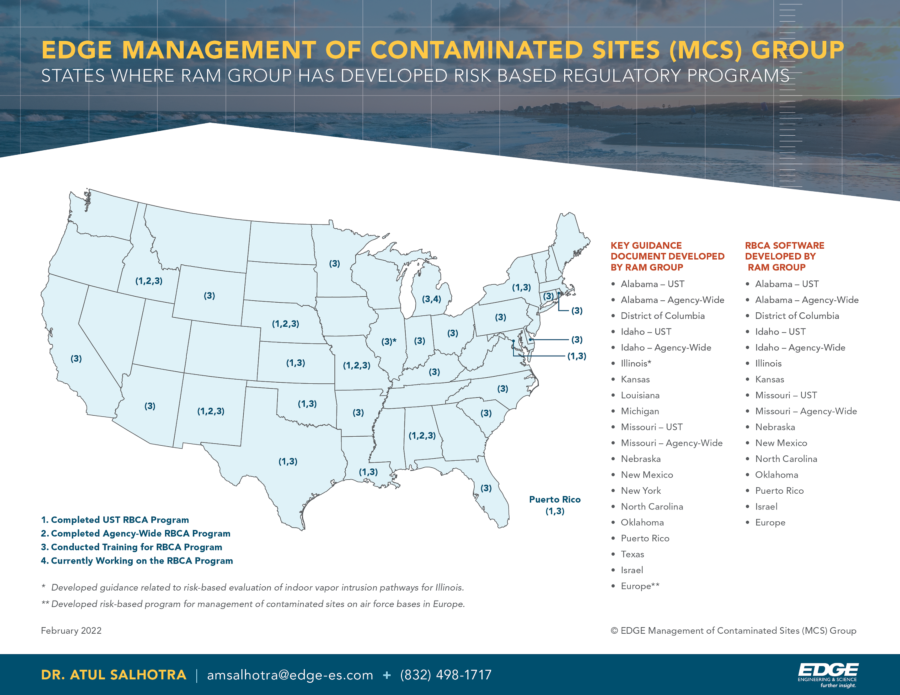
Risk-Based Corrective Action at a 100-Year-Old Chemical Plant: An EDGE Case Study
For more than a century, the John F. Queeny Plant operated on the west bank of the Mississippi River in St. Louis, Missouri. Established in 1901 as the Monsanto Chemical Works, the facility manufactured over 200 products from more than 800 raw materials before finally ceasing operations in 2006 under the ownership of Solutia Inc. (spun off from Monsanto in 1997). Products ranged from industrial chemicals, chemical intermediates, herbicides, and pesticides to food additives and pharmaceuticals. Chemical wastes were primarily stored in tanks and drums for off-site disposal or treated in Monsanto’s incinerator.
Upon closing the plant in 2006, Solutia removed all underground storage tanks from service and demolished the remaining structures, with the goal of redeveloping the site for light industrial and commercial use. With such a long history, the site required substantial corrective action for soil and groundwater contamination. Solutia called on Risk Assessment and Management (RAM) Group, now EDGE’s Management of Contaminated Sites (MCS) Group, since the beginning of January 2022, to evaluate the available soil and groundwater data and perform a risk-based closure for the site.
MCS Services at the Queeny Plant
Led by Dr. Atul M. Salhotra the team utilized the Missouri Risk-Based Corrective Action (MRBCA) Program and the U.S. EPA’s Risk Assessment Guidance for Superfund (RAGS) procedure to perform a comprehensive assessment, the results of which were used to cost-effectively manage the site risk and receive regulatory closure.
As a part of the risk assessment, the team calculated the mass of chemicals discharged into the Mississippi River, the resulting concentrations of specific chemicals in the mixing zone, and the extent of the zone within the Mississippi River. The analysis showed that the calculated concentrations were within the required regulatory levels. The EPA concluded that the discharge of impacted groundwater from the Queeny Plant into the Mississippi River was acceptable. Similarly, the team calculated the risk to the future construction workers and on-site human receptors.
Resource Conservation and Recovery Act (RCRA) corrective action activities since the late 1980s focused on eight solid waste management units (SWMUs). A risk assessment performed in 2002 (2002 RA) using the RAGS procedure identified the need to perform additional evaluation for four SWMUs. In 2005 necessary data was collected on the four SWMUs and site-specific cleanup goals were developed for each in concert with Solutia, the EPA, and the Missouri Department of Natural Resources (MDNR). For risks deemed unacceptable, a conceptual risk management plan was developed for each SWMU. The EPA approved the 2005 RA following multiple meetings and presentations.
The team’s efforts to get CA 750 and the 2005 RA approved resulted in significant savings for Solutia. Approval reduced the need for additional characterization and remediation activities and most importantly prevented Solutia from having to clean the groundwater to drinking water standards, which would have been extremely expensive and possibly impractical. The risk assessment was instrumental in facilitating negotiations for the eventual sale of the site in 2008.
A Track Record of Excellence
Performing risk-based evaluations and getting regulatory acceptance of the results at sites such as the Queeny Plant for Solutia is one of the signature achievements of Dr. Salhotra’s career. His team’s ability to efficiently compile and evaluate data, perform risk-based evaluation of residual impacts related to decades of industrial activities, and achieve risk-based closures is critical for repurposing industrial land and the sustainable development of surrounding communities.
Dr. Salhotra is internationally recognized as a top expert in his field, having developed RBCA programs in 16 states as well as Puerto Rico, Israel, Portugal, and U.S. Air Force bases in Europe. He has conducted training courses in over 25 states and 10 countries and was instrumental in the development of several of the models and methodologies used by the EPA and industry associations for environmental decision making.
Salhotra and team have built an excellent reputation over many years for working equally well with both industry and states to develop and implement RBCA programs that bring value to all stakeholders. Nationwide, the team has completed RBCA projects in 28 states from coast to coast in addition to Dr. Salhotra’s overseas work, including guidance documents, software development, and personnel training.

Dr. Salhotra’s leadership has been invaluable for making the MCS Group a premium asset in EDGE’s toolbox to serve our clients. Our MCS staff members are experts at cost-effective management of contaminated sites, developing and implementing solutions that can reduce or eliminate current and future liabilities, including:
• Site Characterization
• Human Health Risk Assessment
• Ecological Risk Assessment
• Risk-Based Corrective Action (RBCA) Guidance, Training, and Software
• Litigation Support/Expert Testimony
EDGE’s deep well of experience extends to every aspect of the risk assessment and corrective action process, from early investigation to defending the end results in court. No matter where your site is located or the program under which it is being evaluated, Dr. Salhotra and the MCS Group can work with you to find a solution that will ensure the protection of human health and the environment in the most cost-effective and sustainable manner.
https://www.epa.gov/mo/former-solutia-jf-queeny-facility-st-louis-missouri-fact-sheet-may-2019
